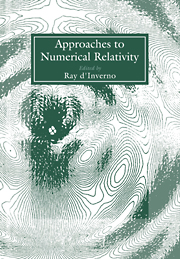Book contents
- Frontmatter
- Contents
- Contributors
- Introduction
- Preface
- PART A THEORETICAL APPROACHES
- Numerical relativity on a transputer array
- Some aspects of the characteristic initial value problem in numerical relativity
- The characteristic initial value problem in general relativity
- Algebraic approach to the characteristic initial value problem in general relativity
- On hyperboloidal hypersurfaces
- The initial value problem on null cones
- Introduction to dual-null dynamics
- On colliding plane wave space-times
- Boundary conditions for the momentum constraint
- On the choice of matter model in general relativity
- A mathematical approach to numerical relativity
- Making sense of the effects of rotation in general relativity
- Stability of charged boson stars and catastrophe theory
- PART B PRACTICAL APPROACHES
- PANEL DISCUSSION
Making sense of the effects of rotation in general relativity
Published online by Cambridge University Press: 15 December 2009
- Frontmatter
- Contents
- Contributors
- Introduction
- Preface
- PART A THEORETICAL APPROACHES
- Numerical relativity on a transputer array
- Some aspects of the characteristic initial value problem in numerical relativity
- The characteristic initial value problem in general relativity
- Algebraic approach to the characteristic initial value problem in general relativity
- On hyperboloidal hypersurfaces
- The initial value problem on null cones
- Introduction to dual-null dynamics
- On colliding plane wave space-times
- Boundary conditions for the momentum constraint
- On the choice of matter model in general relativity
- A mathematical approach to numerical relativity
- Making sense of the effects of rotation in general relativity
- Stability of charged boson stars and catastrophe theory
- PART B PRACTICAL APPROACHES
- PANEL DISCUSSION
Summary
Abstract. It is argued that having a good conceptual understanding of relativistic effects is very important when undertaking large computations in numerical relativity. The radius of gyration (the square root of the ratio of the specific angular momentum to the angular velocity) is proposed as a useful quantity for the analysis of effects which are related to rotation.
INTRODUCTION
This paper is concerned with the effects of rotation in general relativity and parts of it draw heavily on joint work carried out together with M. A. Abramowicz of NORDITA and Z. Stuchlik of the Silesian University of Opava (see Abramowicz et al. 1992).
Among the areas of particular interest for current work in numerical relativity are the following:
(i) collisions of neutron stars or black holes;
(ii) realistic three-dimensional relativistic gravitational collapse;
(iii) non-axisymmetric behaviour of compact objects;
(iv) accretion onto compact objects;
(v) processes in the early universe;
(vi) behaviour of gravitational waves;
(vii) formation of singularities.
In much of this, the calculations are intrinsically three-dimensional and rotation plays a crucial role. The question arises: how well do we understand the effects of rotation in general relativity? One could argue that this is unimportant; there is a system of equations to be solved for given initial conditions and boundary conditions and the process is a mechanical one which leads to predictions which could then be tested experimentally, at least in principle.
- Type
- Chapter
- Information
- Approaches to Numerical Relativity , pp. 114 - 129Publisher: Cambridge University PressPrint publication year: 1992
- 2
- Cited by



